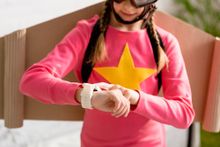A Guide to Teaching Children How to Tell Time

As digital displays aren’t always available, young children should be able to read the time on analog clocks, too. By learning how to tell time, kids become more familiar with numerical values. This knowledge can help them succeed in the STEM curriculum. For a better idea of what age your child should know how to tell time, plus teaching pointers, consult the guide below.
When to Teach Kids to Tell Time
To retain what they’ve learned, kids should learn how to tell time in stages. First, they should understand the concept of time and that each day consists of 24 hours. This generally takes place at 5 or 6 years old. By the age of 6 or 7, they should know each hour has 60 minutes. When told a time, they should be able to move the hands to show it on the clock. Kids focus on these skills, plus learning the difference between a.m. and p.m. at ages 7 and 8. Once a child reaches 9 years old, they should be able to read a clock with little difficulty.
How to Make the Process Easier
 As it aids STEM learning, kids are often introduced to clocks in the classroom. At home, you can buy a child’s analog watch to pique their curiosity. They can see how each hand moves on the face. When you have an activity on the agenda, tell them what time the event will start and show them where hands are on the watch. Once the activity is over, announce the time and tell them to look at how much the hands moved from the original position. You can explain what the different marks mean to help them understand.
As it aids STEM learning, kids are often introduced to clocks in the classroom. At home, you can buy a child’s analog watch to pique their curiosity. They can see how each hand moves on the face. When you have an activity on the agenda, tell them what time the event will start and show them where hands are on the watch. Once the activity is over, announce the time and tell them to look at how much the hands moved from the original position. You can explain what the different marks mean to help them understand.
To ensure your child grasps numerical values and other fundamental concepts for a STEM education, reach out to the professionals at FasTracKids/JEI Learning Center. The Brooklyn, NY-based learning center provides reading and math enrichment programs to enhance children’s creativity and improve their critical-thinking skills. Visit the center online for STEM program details and call (347) 987-4450 to discuss enrollment options.
About the Business
Have a question? Ask the experts!
Send your question

